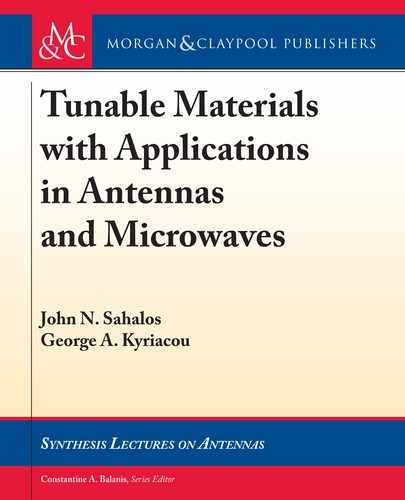
3.6. EXCHANGE–FIELD INTERACTION 81
waves even within a small ferrite sample [4]. Spin waves as well as magnetostatic waves absorb
energy from the applied magnetic field and heat up the ferrite.
Our primary task in this section is the study of the “spin-wave dispersion equation,”
which will serve as a tool for the determination of their spectrum, also known as “spin-wave
manifold.” e latter will also serve as a reference point for the determination of the magne-
tostatic wave spectrum. As explained above, the key to spin-wave analysis is the consideration
of exchange fields. is is not a trivial task. On the contrary, an accurate analysis requires a
quantum-mechanical approach. erefore, the analysis below focuses on an intuitive physical
understanding rather than a mathematically rigorous one, which can be found in the cited ref-
erences [12] and [14–38].
3.6 EXCHANGE–FIELD INTERACTION
Exchange energy has an electrostatic origin, which stems from electron wavefunctions (space
and spin together) interacting toward the minimization of Coulomb energy [6, 12, 14, 15].
Depending upon the material, exchange interaction is due to the electronic orbital overlap of
neighboring atoms, either direct or mediated by conduction electrons (see [14] and references
therein). e latter is called “RKKY (Ruderman–Kittel–Kasuya–Yosida) interaction” or “indirect
exchange.”
ere is another type of interaction called “super exchange,” where the electronic orbital
overlap is mediated by intervening non-magnetic ions. From a quantum-mechanics point of
view, exchange coupling is a consequence of the Pauli exclusion principle, which states that
“two electrons cannot occupy the same quantum state at the same place and time.” Here the
“spin up” and “spin down” quantum states are considered. e consequence of this principle
is that two parallel spins cannot overlap. Overlapping can occur only when two spins are anti-
parallel. However, in this manner, the Pauli exclusion principle keeps parallel spins apart, which,
in turn, lowers their electrostatic energy. eir exchange energy is equal to the amount by which
the Coulomb energy is reduced.
In general, the exchange energy density W
ex
, can be written in a form also known as
“Heisenberg Hamiltonian” (e.g., [12, 14]):
W
ex
D
1
V
X
<m;n>
J
mn
N
S
m
N
S
n
; (3.15)
where V is the volume of the material,
N
S
m
and
N
S
n
are the atomic spins of the mth and nth atoms,
and J
mn
is a quantum-mechanical coefficient known as “the exchange internal.” Equation (3.15)
has a discrete form and, in general, assumes a summation of the exchange energy involved in the
interaction of all spin pairs within the sample volume. It is helpful to give the following form
for the exchange energy of any .m; n/ pair [15]:
W
mn
D J
mn
N
S
m
N
S
n
D J
mn
N
m
g
B
N
n
g
B
D
J
mn
g
2
2
B
N
m
N
n
: (3.16)

82 3. FINITE FERRITE SAMPLES
In the above equation, the atomic spins
N
S
m
and
N
S
n
are actually expressed in terms of the
atomic magnetic moments N
m
and N
n
through the well-known expression
N
i
D g
B
N
S
i
; (3.17)
where g is the Lande factor and
B
is the Bohr magneton.
Micromagnetic calculations in the discrete form of expression (3.15) are too complicated
for real samples since only calculations up to a few atoms are feasible. For this purpose, only
macro-magnetic (macroscopic) theories are capable of handling the problem. Toward this di-
rection, the discrete exchange is approximated by a continuous function (often accounting for
the six nearest neighboring spins) and exchange energy density is expressed in terms of the local
magnetization components (M
x
; M
y
, and M
z
) [12–25] as:
W
ex
D A
n
.
rm
x
/
2
C
rm
y
2
C
.
rm
z
/
2
o
D A
ˇ
ˇ
r
N
M
ˇ
ˇ
2
j
M
j
2
; (3.18a)
where Om D
N
M =
ˇ
ˇ
N
M
ˇ
ˇ
is the unit vector along the local magnetization direction, and A denotes
the exchange or stiffness constant given in general by:
A D
J S
2
˛
K
neighbor
: (3.18b)
For a cubic crystal and six neighboring spins, it is:
A D
J
2
2
B
g
2
: (3.18c)
e expressions assume that only the nearest K
neighbor
atoms interact, and this number
depends on the crystalline structure of the material (K
neighbor
D 1 for cubic, 2 for body centered
cubic (BCC), 4 for face centered cubic (FCC), and 2
p
2 for hexagonal close-packed (HCP)).
Moreover, ˛ is the lattice constant (mean distance between atoms). e neighboring spins are
assumed to be aligned in parallel,
N
S
m
D
N
S
n
D
N
S D N=g
B
having the same exchange integral
J
mn
D J . Volume V in (3.15) is approximated as V ˛
3
, while the spin summation yields an
˛
2
in the numerator. Likewise, the spin direction in (3.18a) is assumed to be identical to that of
local magnetization, i.e.,
N
S D Om
ˇ
ˇ
N
S
ˇ
ˇ
.
e exchange interaction can be represented by an effective magnetic field (
N
H
ex
eff
). Since
magnetic energy can be written as an integral of
1=2
N
M
N
H
, the effective field can be defined
by the total derivative of energy variation [24]:
N
H
e
ex
D
ıW
ex
ıM
D
2A
j
M
j
r
2
Om.Nr/ D H
e
˛
2
r
2
N
M .Nr; t/
ˇ
ˇ
N
M
ˇ
ˇ
; (3.19a)
..................Content has been hidden....................
You can't read the all page of ebook, please click here login for view all page.
